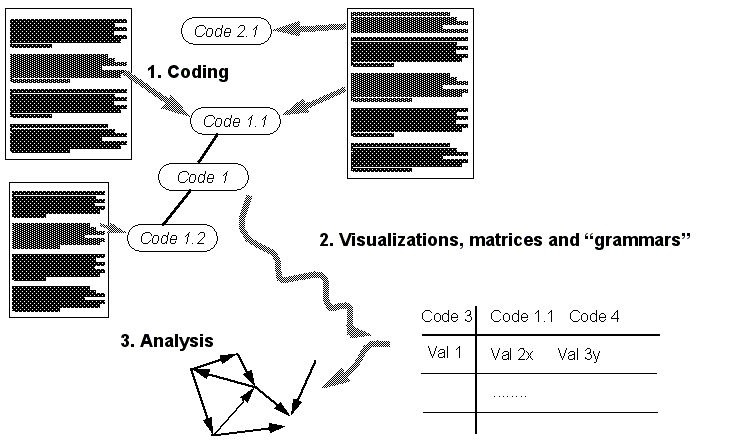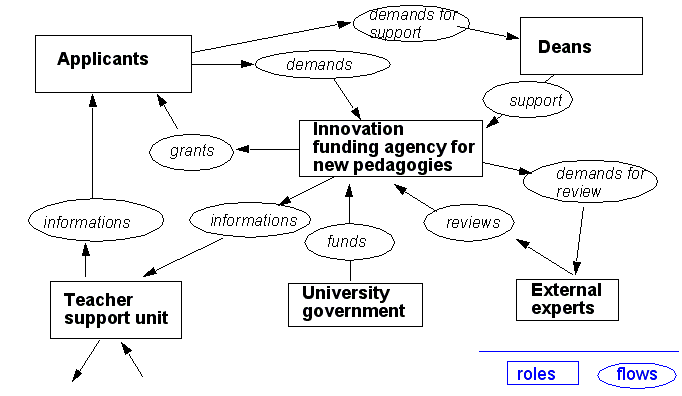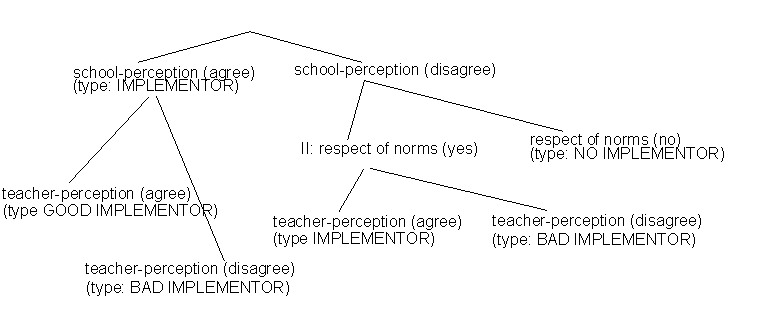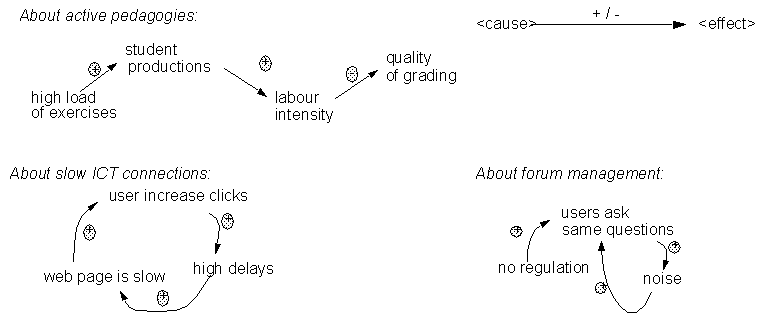Methodology tutorial - qualitative data analysis
This article or section is currently under construction
In principle, someone is working on it and there should be a better version in a not so distant future.
If you want to modify this page, please discuss it with the person working on it (see the "history")
<pageby nominor="false" comments="false"/>
Qualitative data analysis
This is part of the methodology tutorial (see its table of contents).
- Learning goals
- Understanding the purpose of code data and creating code books
- Learn about some descriptive analysis of variables techniques (including situations and roles)
- Learn about some causal analysis techniques
- Prerequisites
- Methodology tutorial - theory-finding research designs
- Methodology tutorial - qualitative data acquisition methods
- Level
- It aims at beginners. As with any method, you will have to practise and you likely will need some (human) guidance.
- Quality
- Slide style, should be expanded
Introduction: classify, code and index
In short, qualitative data analysis usually implies to related and iterative steps. See Methodology tutorial - theory-finding research designs for the general principle.
(1) Data needs to be coded and indexed so that you can find it for data analysis. More particularly:
- Information coding allows to identify variables and values, therefore allows for systematic analysis of data (and therefore reliability)
- ensures enhanced construction validity, i.e. that you look at things that will allow you to measure concept
(2) You then can do visualizations, matrices, grammars, etc.
(3) Interpret these
- Before we start - Keep your documents and ideas safe !
(1) Write memos (conservation of your thoughts). It is useful to write short memos (vignettes) when an interesting idea pops up, when you looked at something and want to remember your thoughts
(2) Create contact sheets that allow you remember your field work. After each contact (telephone, interviews, observations, etc.), make a short data sheet that should include:
- A clear tag for indexing purposes (filename or tag on paper), e.g. CONTACT_senteni_2005_3_25.doc.
- Type of contact, date, place, and a link to the interview notes, transcripts.
- Principal topics discussed and research variables addressed (or pointer to the interview sheet).
- Initial interpretative remarks, new speculations, things to discuss next time.
(3) Index your interview notes:
- Put your transcription (or audio/video files or audio tapes) in a safe place
- Assign a code to each "text", e.g. INT-1 or INTERVIEW_senteni_3_28-1. The same code could be used as filename.
- You also may insert the contact sheet (see above)
- Number the pages if you take notes manually (they can fall down ...)
(4) Do not trust your hard-disk !
Codes and categories
First step in qualitative data analysis is coding.
![]() A code is a “label” to tag a variable (concept) and/or a value found in a "text"
A code is a “label” to tag a variable (concept) and/or a value found in a "text"
The coding principle
- A code is assigned to each (sub)category, i.e. theoretical variable you work on
- In other words: you must identify variable names
- In addition, you can for each code assign a set of possible values (e.g.: “positive”/”neutral/”negative)
- You then will systematically scan all your texts (documents, interview transcripts, dialogue captures, etc.) and tag all occurrences of variables.
- Three very different coding strategies exist as we shall see later:
- Code-book creation according to theory
- Coding by induction (according to “grounded theory”)
- Coding by ontological categories
- Benefit of coding
- Coding will allow you to find all informations regarding variables of interest to your research
- Reliability will be improved
- The procedure with a picture
Technical Aspects of coding
- The safest and most reliable way to code is to use some specialized software
- e.g. Atlas or Nvivo (NuDist),
- however, this takes a lot of time !
- For a smaller piece (e.g. a master thesis), we suggest to simply tag the text on paper
- you can make a reduced photocopy of the texts to gain some space in the margins
- overline or circle the text elements you can match to a variable
- make sure to distinguish between codes and other marks you may leave.
- Don’t use "flat" and long code-books, introduce hierarchy (according to dimensions identified)
- Each code should be short but also mnemonic (optimize)
- e.g. to code according to a schema “principal category” - “sub-category” (“value”) use a code like:
CE-CLIM(+)
instead of:
external_context -climate (positive)
- Don’t start coding before you have good idea on your coding strategy !
- either your code book is determined by you research questions and associated theories, frameworks, analysis grids
- or you really learn how to use an inductive strategy like "grounded theory".
Coding reliability
Assigning a code to a "text" segment is not always obvious and coding similar passages exactly the same way even less. In other words, we have a reliability problem.
There are two ways of improving reliability:
- Use clear and operational categories
- Use two or three coders (yourself and a friend) and compute intercoding index. If it is low, you will have to revise your coding scheme.
There exist several formula to compute intercoder (inter-rater) reliability. The most simple one is:
reliability = number of agreements (same coding)
/ total codes (agreements plus disagreements)
Read this for a very good introduction.
Code-book creation and management
Code-book creation according to theory
![]() The list of variables (and their codes), is defined through theoretical reasoning, e.g.
The list of variables (and their codes), is defined through theoretical reasoning, e.g.
- analytical frameworks, analysis grids
- concepts found in the list of research questions and/or hypothesis
Example from an innovation study (about 100 codes):
| Categories | Codes | Theoretical references | |
|---|---|---|---|
| properties of the innovation | PI |
....(fill for your own code book)..... | |
| external context | EC | ||
| demography | CE-D | ||
| support for the reform | CE-S | ||
| internal context | IC | ||
| adoption processes | AP | ||
| official chronology | PA-OC | ||
| dynamics of the studied site | DS | ||
| external and internal assistance | EIA | ||
| causal links | CL | ||
Coding by induction (according to “grounded theory”)
Grounded theory (Glaser, Strauss) refers to a set of approaches that that focus on interpretation and theory building, i.e. it is a fully inductive approach. The researcher starts by coding a small data set and then increases the sample in function of emerging theoretical questions. Categories (codes) can be revised at any time.
“Grounded theory begins with a research situation. Within that situation, your task as researcher is to understand what is happening there, and how the players manage their roles. You will mostly do this through observation, conversation and interview. After each bout of data collection you note down the key issues: this I have labelled "note-taking".
Constant comparison is the heart of the process. At first you compare interview (or other data) to interview (or other data). Theory emerges quickly. When it has begun to emerge you compare data to theory.
The results of this comparison are written in the margin of the note-taking as coding. Your task is to identify categories (roughly equivalent to themes or variables) and their properties (in effect their sub-categories). Grounded theory: a thumbnail sketch, retrieved 11:55, 15 October 2008 (UTC))”
Typically, you'd both code phenomena in isolation and relations (so-called axial coding). On starting point for axial coding could be these big abstract observation categories:
- conditions (causes of a perceived phenomenon)
- interactions between actors
- strategies and tactics used by actors
- consequences of actions
Read more in [Introduction to Grounded Theory].
To use this approach you really should document yourself, as beginner you'd likely fall into various traps, in particular selection and confirmation biases, i.e. you only look at things that will interest you for one or another reason.
Coding by ontological categories
Instead of initially creating a code book from variables found in your research questions or "inductive" coding à la grounded theory, you also start by creating or using a vocabulary for a given domain. This strategy is a compromise between “grounded theory” and “theory driven” approaches.
Below is a table that lists things you could observe in an organization (Bogdan and Biklen, cited by Miles & Huberman:1994 61)
| Types | Explanantion |
|---|---|
| Context/Situation | information on the context |
| Definition of the situation | interpretation of the analyzed situation by people |
| Perspectives | global views of the situation |
| Ways to look at people and objects | detailed perceptions of certain elements |
| Processes | sequences of events, flow, transitions, turning points, etc. |
| Activities | structures of regular behaviors |
| Events | specific activities (non regular ones) |
| Strategies | ways of tackling a problem (strategies, methods, techniques) |
| Relations and social structure | informal links |
| Methods | comments (annotations) of the researcher |
In the literature, you may find several other such "accounting schemes".
Pattern codes
Some researchers also code patterns (relationships). Simple encoding (above) breaks data down to atoms, categories), whereas pattern coding identifies relationships between atoms.
The ultimate goal is to detect (and code) regularities, but also variations and singularities.
Some suggested operations:
- Detection of co-presence between two values of two variables
- E.g. people in favor of a new technology (e.g. ICT in the classroom) have a tendency to use it.
- Detection of exceptions
- e.g. technology-friendly teachers who don’t use it in the classroom
- In this case you may introduce new variable to explain the exception, e.g. the attitude of the superior., of the group culture, the administration, etc.
- Exceptions also may provoke a change of analysis level (e.g. from individual to organization)
Attention: a co-presence does not prove causality
Descriptive matrices and graphics
![]() Qualitative analysis attempts to put structure to data
(as in exploratory quantitative techniques)
Qualitative analysis attempts to put structure to data
(as in exploratory quantitative techniques)
In short: Analysis = visualization
There exist 2 popular types of analysis:
- A matrix is a tabulation engaging at least one variable, e.g.
- Tabulations of central variables by case (equivalent to simple descriptive statistics like histograms)
- Crosstabulations allowing to analyze how 2 variables interact
- Graphs ( networks ) allow to visualize links:
- temporal links between events
- causal links between several variables
- etc.
- Some advice
- When you use these techniques always keep a link to the source (coded data)
- Try to fit each matrix or graph on a single page (or make sure that you can print things made by computer on a A3 pages)
- you have to favor synthetic vision, but still preserve enough detail to make your artifact interpretable
- Consult specialized manuals e.g. Miles & Huberman, 1994 for recipes or get inspirations from qualitative research in the same domain
![]() In this tutorial we can not cover all possible types of analysis, but just provide a few examples. Before you start doing any sort of analysis, think about what you need to answer your research questions !
In this tutorial we can not cover all possible types of analysis, but just provide a few examples. Before you start doing any sort of analysis, think about what you need to answer your research questions !
The “context chart”,Miles & Huberman (1994:102)
This technique allows to visualize relations and information flows between rôles and groups
- Example - Work flow for a "new pedagogies" program at some university
There exist codified "languages" for this type of analysis, e.g. UML or OSSAD
Once you clearly identified and clarified formal relations, you can use the graph to make annotations (like below)
Check-lists, Miles & Huberman (1994:105)
Check lists allow to make detailed summary for an analysis of an important variable.
Example: "external support is important for succeeding a reform project"
|
Examples for external support |
At counselor level |
At teacher level |
|---|---|---|
|
Analysis of deficiencies |
Fill in each cell as below | |
|
Teaching training | ||
|
Change monitoring | ||
|
Incentives | ||
|
Group dynamics |
adequate: “we have met an organizer 3 times and it has helped us” (ENT-12:10) |
not adequate: “we just have informed” (ENT-13:20) |
|
etc. .. |
||
Such a table displays various dimensions of and important variable (external support). E.g. in the example above the values of the variable "external support" are listed in the left column
In the other columns we insert summarized facts as reported by different roles.
Review Question: Imagine how you would build such a grid to summarize teacher’s, student’s and assistant’s opinion about technical support for an e-learning platform
Chronological tables Miles & Huberman (1994:110)
- Can summarize a studied object’s most important events in time
Example: Task assignments for a blended project-oriented class
|
Activity |
Date |
imposed tools (products) | |
|
1 |
Get familiar with the subject |
21-NOV-2002 |
links, wiki, blog |
|
2 |
project ideas, Q&R |
29-NOV-2002 |
classroom |
|
3 |
Students formulate project ideas |
02-DEC-2002 |
news engine, blog |
|
4 |
Start project definition |
05-DEC-2002 |
ePBL, blog |
|
5 |
Finish provisional research plan |
06-DEC-2002 |
ePBL, blog |
|
6 |
Finish research plan |
11-DEC-2002 |
ePBL, blog |
|
7 |
Sharing |
17-DEC-2002 |
links, blog, annotation |
|
8 |
audit |
20-DEC-2002 |
ePBL, blog |
|
9 |
audit |
10-JAN-2003 |
ePBL, blog |
|
10 |
Finish paper and product |
16-JAN-2003 |
ePBL, blog |
|
11 |
Presentation of work |
16-JAN-2003 |
classroom |
- This type of table is useful to identify important events.
- You can add other information, e.g. tools used in this example
Matrices for roles (function in an organization or program)
Miles & Huberman (1994:124)
- Crossing social roles with one or more variables
The abstract principle can be summarized as follows (see below for an example):
| roles | persons | variable 1 | variable 2 | variable 3 |
|---|---|---|---|---|
| role 1 | person 1 | cells are filled in with values (pointing to the source) | ||
| person 2 | ||||
| ..... | ||||
| rôle 2 | person 9 | |||
| person 10 | ||||
| ..... | ..... | |||
| role n | person n | |||
|
..... | ||||
- Crossing roles with roles
| role 1 | ... | role 3 | |
|---|---|---|---|
| role 1 | fill in all sorts of informations about interactions | ||
| ... | |||
| role 3 | |||
Example: Evaluation of the implementation of a help desk software
| Actor | Evaluation | assistance provided | Assistance received | Immediate effects | Long term effects | Explanation of the researcher |
|---|---|---|---|---|---|---|
| Manager | - | - | - | demotivating | threatened the program | Felt threatened by new procedures |
| Consultant | + | help choosing the right soft. involved himself | - | contributed to the start of the experiment | - | .... |
| “Help-desk worker” | +/- | debugging of machines, little help with software | better job satisfaction because of the tool | slight improvement of throughput | is still overloaded with work | |
| Users | +/- | A few users provided help to peers with the tool | debugging of machines, little help with software | Were made aware of the high amount of unanswered questions | slight improvement of work performance | .... |
Crossing between roles to visualize relations:
| role 1 | trainers | role 3 | |
|---|---|---|---|
| rôle 1 | |||
| trainers | “don’t coordinate very much” (1) | dosn’t receive all the information (2) | |
| rôle 3 |
Techniques to hunt correlations
Matrices ordered according to concepts (variables)
- Clusters (co-variances of variables, case typologies)
- An idea that certain values should "go together": Hunt co-occurrences in cells
- E.g.: “Can we observe a correlation between expressed needs for support and
expressed needs for training for a new collaborative platform (data from teachers’s interviews)?
| case | var 1 | need for support | need for training | need for directives |
|---|---|---|---|---|
| case 1 | important | important | important | |
| case 2 | not important | not important | not important | |
| case 3 | important | important | important | |
| case 4 | yyy | not important | not important | not important |
| case 5 | ..... | important | important | important |
| case 6.... | important | not important | not important |
- This table shows e.g. that need for support and need for training seem to go together,
e.g. cases 1,3,5 have association of "important", cases 2 and 4 have association of "not important".
- See next page how we can summarize this sort of information in a crosstab
- Co-variance expressed in a corresponding crosstab
| training needs * support needs | need for support | ||
|---|---|---|---|
| yes | no | ||
| need for training |
yes | 3 | 1 |
| no | 1 | 2 | |
We can observer a correlation here: "blue cells" (symmetry) is stronger than "magenta"!
You should check the data above to see if we did this right ...
Example typology with the same data:
| Type 1: "anxious" |
Type 2: "dependent" |
Type 3: "bureaucrats" |
Type 4: "autonomists" | |
|---|---|---|---|---|
| case 1 | X | |||
| case 2 | X | |||
| case 3 | X | |||
| case 4 | X | |||
| case 5 | X | |||
| case 6 | X | |||
| Total individuals per type |
3 | 1 | 0 | 2 |
We can observe emergence of 3 types to which we assign "labels"
Note: for more than 3 variables use a cluster analysis program
- Additional example
The table shows co-occurrence between values of 2 variables. The idea is to find out what effect different types of pressure have on ICT strategies adopted by a school.
| Strategies of a school | |||||
|---|---|---|---|---|---|
| Type of pressure | strategy 1:no reaction | strategy 2:a task force is created | strategy 3:internal training programs are created | strategy 4:resources are reallocated | strategy 5: ..... |
| Letters written by parents | (N=4)(p=0.8) | (N=1)(p=0.2) | |||
| Letters written by supervisory boards | (N=2)(p=0.4) | (N=3)(p=0.6) | |||
| newspaper articles | (N=1)(p=100%) | ||||
| type ... | ..... | .... | |||
Recall: Interpretation of crosstabulation
See also: Methodology tutorial - quantitative data analysis (Cross-tabulation)
We would like to estimate the probability that a given value of the independent (explaining) variable entails a given value of the dependent (explained) variable.
- The procedure
- calculate the % for each value of the independent variable
- Note: this can be either the line or the column depending on how you orient your table
- compute the % in the other direction
| Variable y to explain = Strategies of action | ||||
|---|---|---|---|---|
| Explaining variable x |
do nothing | send a mail | write a short tutorial | Total |
| Students making indirect suggestion | 4 (80%) | 1 (20%) | 5 (100 %) | |
| Students explicitly complaining |
2 (40%) | 3 (60%) | 5 (100%) | |
Interpretation: “... if students explicitly complain, the tutor will react more strongly and engage in more helpful activities.”
- See: quantitative data analysis.
Typology and causality graphs
There are no limits of what you can draw. Basically such analysis just use a more or less precise language to draw concept maps.
Below we just show two examples.
Typology graphs
- Display attributes of types in a tree-based manner
Example: Perception of a new program by different implementation agencies (e.g. schools) and its actors (e.g. teachers)
Subjective causality graphs
A simple causality graphs relates variables (concepts) with directed arrows.
There exist many variants. One older method is “operational coding” (Axelrod, 1976) and is somewhat popular in political science. It allows to compute outcomes of reasoning chains
Example: Teacher talking about active pedagogies, ICT connections, Forums
Software
Depending on your discipline of reference, you may be familiar with different software families that help drawing graphs:
- For concept mapping software, see Concept map
- For UML-supporting diagram software, see Unified modeling language
We also can recommend a good general purpose free diagram software:
Finally, for people who hate to draw, there exist useful free visualization software, in particular:
Links
- Ground theory
- Bob Dick, Grounded theory: a thumbnail sketch
- Steve Borgatti, Introduction to Grounded Theory
- Glaser's Home page
- Grounded theory, Grounded theory (Glaser), Grounded theory (Strauss) (Wikipedia)
Bibliography
- Amanda Coffey, A., Holbrook,B. Atkinson, P., Qualitative Data Analysis: Technologies and Representations, School of Social and Administrative Studies, University of Wales, Cardiff HTML. (This is an overview of the literature without any practical advice)
- Glaser, Barney G. (1992) Basics of grounded theory analysis: emergence vs forcing. Mill Valley, Ca.: Sociology Press.
- Lombard, Matthew; Jennifer Snyder-Duch and Cheryl Campanella Bracken (2008). Practical Resources for Assessing and Reporting Intercoder Reliability in Content Analysis Research Projects, Retrieved from http://www.temple.edu/sct/mmc/reliability/, accessed 20:59, 7 October 2008 (UTC).
- Miles, M. B. & Huberman, A. (1994). Qualitative Data Analysis: An Expanded Sourcebook. Sage. ISBN 0803955405 (This is still the cookbook for structured qualitative analysis.)
- Strauss, Anselm, and Corbin, Juliet (1990) Basics of qualitative research: grounded theory procedures and techniques. Newbury Park: Sage.





